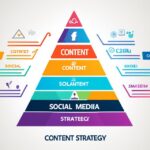Table of Contents
Email marketing has proven to be an effective tool for businesses, with 94% of marketers finding it instrumental in reaching their goals, according to a HubSpot survey. To harness the true potential of email marketing, it is crucial to follow best practices that maximize engagement and conversions. In this section, we will explore the key elements of a successful email marketing content strategy and highlight the best practices to enhance your campaign’s performance.
Email Marketing Best Practices
When it comes to email marketing, following best practices is key to achieving success and maximizing your campaign’s effectiveness. By implementing these email marketing best practices, you can improve engagement, increase conversions, and build strong relationships with your subscribers. Let’s explore some of the top best practices:
- Avoid purchasing contact lists: It may be tempting to buy a ready-made list of contacts, but this can harm your deliverability and reputation. Focus on building your own opt-in list of engaged subscribers instead.
- Avoid using ‘No-Reply’ in sender’s email address: Using a ‘No-Reply’ email address can make your emails feel impersonal and discourage recipients from engaging. Instead, use a friendly and recognizable email address.
- Use fewer than three typefaces in your email design: Keeping your email design clean and consistent helps maintain a professional and cohesive look. Stick to a maximum of three different typefaces to avoid overwhelming your readers.
- Optimize the email’s preview text: The preview text is what recipients see before opening your email. Use this opportunity to craft compelling and engaging copy that entices them to open and read further.
- Include an email signature: Adding a personal touch with an email signature helps establish trust and credibility. Include your name, job title, and contact information.
- Clean your mailing list regularly: Regularly remove inactive or unsubscribed contacts from your mailing list to maintain a healthy and engaged subscriber base.
- Keep the main message and call-to-action above the fold: Ensure that the most important content and actions are visible without scrolling, increasing the chances of engagement and conversion.
- Personalize the email greeting: Addressing recipients by their first name in the email greeting can help create a more personalized and meaningful connection.
- Keep the email width between 500 and 650 pixels: Design your emails to fit within this width range to ensure optimal display across various devices and screen sizes.
- A/B test subject lines and calls to action: Experiment with different subject lines and calls to action to identify what resonates best with your audience and drives higher engagement.
- Include a logo: Adding your logo to your emails helps reinforce your brand identity and makes your emails more recognizable.
- Allow recipients to subscribe to the newsletter: Make it easy for recipients to subscribe to your newsletter if they find value in your emails. Provide clear and accessible subscription options.
By implementing these email marketing best practices, you can enhance the effectiveness of your campaigns and achieve better results. Remember to continuously evaluate and refine your strategies based on analytics and audience feedback to optimize your email marketing efforts.
Inbound Email Marketing Best Practices
When it comes to inbound email marketing best practices, there are several key strategies that can help optimize your email campaigns for success. By following these practices, you can enhance engagement with your audience and improve the effectiveness of your email marketing efforts.
1. Avoid purchasing contact lists
Purchasing contact lists may seem like a quick way to expand your reach, but it’s not an effective long-term strategy. These lists often contain outdated or inaccurate information, resulting in poor email deliverability and low engagement rates. Instead, focus on building your own opt-in list organically through lead generation efforts.
2. Obtain explicit consent from European recipients
With the implementation of the General Data Protection Regulation (GDPR), it is crucial to obtain explicit consent from European recipients before sending them marketing emails. Ensure that your email opt-in forms include a clear consent statement and provide recipients with the option to unsubscribe at any time.
3. Use personal names in the sender’s email address
Avoid using generic ‘No-Reply’ email addresses as the sender. Instead, use personal names to create a more personalized and approachable experience for your recipients. This simple change can improve open rates and make your emails feel more authentic.
4. Use fewer than three typefaces
When designing your emails, keep the typography clean and concise. Using fewer than three typefaces helps maintain a cohesive and professional appearance, ensuring that your messages are easy to read and visually appealing.
5. Optimize the email’s preview text
The preview text is the snippet of text that appears before the recipient opens your email. Make sure to optimize this text to provide a compelling preview that entices readers to open your message.
6. Include an email signature from a specific person
Including an email signature from a specific person adds a personal touch to your emails. It helps establish trust and builds a stronger connection with your audience. Ensure that the signature includes relevant contact information and links to social media profiles.
7. Regularly clean the mailing list
Regularly clean your mailing list by removing inactive subscribers or email addresses with a high bounce rate. This helps maintain a healthy subscriber list and ensures that your emails are reaching engaged recipients.
8. Keep the main message and call-to-action above the fold
Place the main message and call-to-action above the fold, meaning they should be visible without scrolling. This ensures that your most important content is immediately visible to recipients, increasing the likelihood of engagement and conversions.
9. Personalize the email greeting with the recipient’s first name
Personalization goes a long way in capturing your recipient’s attention. Include the recipient’s first name in the email greeting to make them feel valued and create a more personalized experience.
10. Keep the email width between 500 and 650 pixels
To ensure that your emails are mobile-friendly and display correctly on various devices, keep the email width between 500 and 650 pixels. This width allows your emails to adapt to different screen sizes and ensures a seamless viewing experience for your recipients.
11. A/B test subject lines and calls to action
A/B testing is a powerful tool to optimize your email campaigns. Test different subject lines and calls to action to determine what resonates best with your audience and drives higher open and click-through rates.
12. Include a logo
Including your logo in your emails helps reinforce your brand identity and increases brand recognition. It adds a professional touch to your emails and helps recipients associate your messages with your brand.
13. Allow recipients to subscribe to the newsletter
Make it easy for recipients to subscribe to your newsletter by including a clear and prominent subscription option in your emails. This allows interested individuals to stay updated and engaged with your brand.
A complete table providing an overview of the inbound email marketing best practices:
| Best Practices |
|———————-|
| Avoid purchasing contact lists |
| Obtain explicit consent from European recipients |
| Use personal names in the sender’s email address |
| Use fewer than three typefaces |
| Optimize the email’s preview text |
| Include an email signature from a specific person |
| Regularly clean the mailing list |
| Keep the main message and call-to-action above the fold |
| Personalize the email greeting with the recipient’s first name |
| Keep the email width between 500 and 650 pixels |
| A/B test subject lines and calls to action |
| Include a logo |
| Allow recipients to subscribe to the newsletter |
Developing a Targeted Email Content Plan
Developing a targeted email content plan is essential for a successful email marketing strategy. By understanding the needs and preferences of your target audience, you can create compelling content that engages and resonates with them.
Start by establishing your target audience and creating personas to gain deeper insights into their interests, pain points, and motivations. This will help you tailor your email content to address their specific needs.
Choosing a relevant topic is crucial for capturing your audience’s attention. Conduct research and stay updated on industry trends to identify topics that are of interest to your audience. Additionally, speak in a language that resonates with your audience, using clear and concise copy that is easy to understand.
When creating email content, it’s important to consider key metrics and the different stages of the marketing funnel. Align your content with each stage, whether it’s raising awareness, nurturing leads, or driving conversions. This will ensure that your emails are targeted and effective.
Create engaging content that provides value to your subscribers. This can include educational content, offers, promotions, or exclusive insights. Remember to highlight the benefits and address any pain points your audience may have.
With the increasing use of mobile devices, optimizing your email content for mobile is crucial. Ensure that your emails are mobile-friendly, with responsive design and optimized images for a seamless experience on any device.
Testing your email content is essential for refining your strategy. Conduct A/B tests to compare different subject lines, email formats, and calls to action. Use the results to iterate and improve your email content, focusing on what resonates best with your audience.
Remember to measure the performance of your email campaigns using key metrics such as open rates, click-through rates, and conversions. This data will provide valuable insights into the effectiveness of your targeted email content plan.
By developing a targeted email content plan, you can deliver personalized and engaging emails that resonate with your audience, driving higher open rates, click-through rates, and conversions. Continuously refine your strategy based on audience feedback and data analysis to optimize your email marketing efforts.
Conclusion
Developing a content strategy for email marketing is crucial for effective engagement and conversions. By following best practices, such as avoiding the purchase of contact lists, personalizing emails, optimizing design, and creating engaging content, businesses can maximize their email marketing efforts. It’s vital to continuously refine and improve the strategy based on key metrics and audience feedback.
With a targeted email content plan in place, businesses can build strong relationships with their subscribers and achieve success in their email marketing campaigns. By understanding the needs and preferences of the target audience, choosing relevant topics, and speaking their language, businesses can create valuable and engaging content that resonates with recipients.
It’s also important to consider different stages of the marketing funnel when developing email content. By tailoring content to specific stages and aligning it with key metrics, businesses can nurture leads and guide them towards making a purchase or taking the desired action. By prioritizing mobile optimization, businesses can ensure that their emails are accessible and visually appealing across different devices, reaching a wider audience.
Testing the email content and measuring its performance are integral parts of a successful email marketing strategy. By analyzing open rates, click-through rates, conversion rates, and other key metrics, businesses can gain insights into what works best and make data-driven decisions. By continuously refining and improving the email content strategy, businesses can stay ahead of the competition and achieve their email marketing goals.
FAQ
What are some best practices for email marketing?
Some best practices for email marketing include not purchasing contact lists, optimizing email design, personalizing email greetings, and regularly cleaning the mailing list.
Should I purchase contact lists for email marketing?
No, purchasing contact lists is not recommended for email marketing. It’s important to build your own organic list of subscribers who are genuinely interested in your content or offerings.
Can I use a ‘No-Reply’ email address as the sender?
It is advisable to avoid using a ‘No-Reply’ email address as the sender. Using personal names or a specific person’s name in the sender’s address can make the email more personalized and engaging to recipients.
How many typefaces should I use in my email design?
It is recommended to use fewer than three typefaces in your email design. Using too many typefaces can make the design cluttered and difficult to read.
What is the ideal width for an email?
The ideal width for an email is between 500 and 650 pixels. This ensures that the email is easily viewable on different devices and screen sizes.
Should I personalize the email greeting?
Yes, it is highly recommended to personalize the email greeting. Addressing the recipient by their first name can create a more personalized and engaging experience for them.
What is A/B testing and why is it important?
A/B testing involves sending different versions of an email to different segments of your audience to see which version performs better. It is important because it allows you to gather data and insights to optimize your email content and increase engagement.
Can I include my company logo in the email?
Yes, it is advisable to include your company logo in the email. This helps in brand recognition and creates a professional look for your email.
How can I allow recipients to subscribe to my newsletter?
You can include a clear call-to-action in your email, inviting recipients to subscribe to your newsletter. This can be in the form of a clickable button or a hyperlink to a subscription page on your website.













